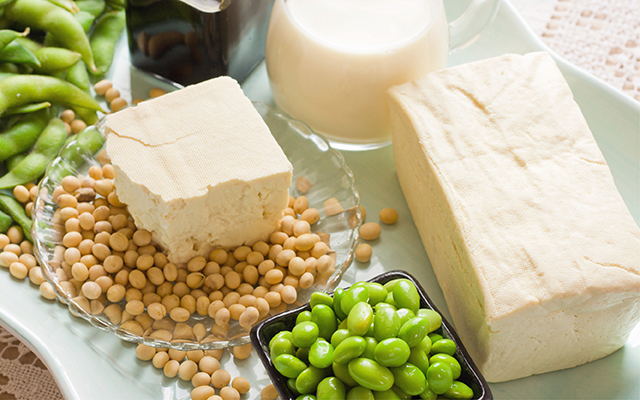As someone who is conscious of her health, I spent years cultivating a vegetarian diet that included enough protein to fuel my busy lifestyle. I knew products made from soybeans were high in protein and a good source of B vitamins, so I strove to eat soy daily — soymilk, soy yogurt, tofu, soy hot dogs, you name it. I usually avoided products with ingredients I could not pronounce, but if they were attached to soy, I let it slide. Soy protein isolate? Great, I thought to myself. They’ve isolated the protein from the soybean to make it more concentrated. Hydrolyzed soy protein? Sure.
Now, admittedly, I didn’t find good rationalizations for all the soy-based products I consumed, but I wasn’t too worried. After all, in 1999 the Food and Drug Administration (FDA) approved labeling that designated soy products as “heart healthy.” Soy ingredients weren’t only safe — they were beneficial.
After more than a decade of consuming various forms of soy, I felt reasonably fit, but in 2005, I stopped menstruating. I was just 29 years old. I couldn’t figure out why my stomach was so upset after I ate edamame or why I was often moody and bloated. It didn’t occur to me at the time to question soy, the sanctioned heart protector and miracle food.
I’ve had a lifelong interest in how food affects health, and so, in my early 30s, I decided to become a certified nutrition consultant specializing in holistic health. In my classes, I kept running across studies that talked about the wide range of risks associated with eating soy: endocrine disruption, digestive problems, infertility, decreased sex drive — and even the potential to contribute to certain cancers. As I began to learn about these potential dangers, I began wondering why no one was talking about the subject in the popular press or health media.
According to Kaayla Daniel, PhD, a certified clinical nutritionist and author of The Whole Soy Story: The Dark Side of America’s Favorite Health Food, the FDA pushed the health benefits of soy despite massive evidence to the contrary — and against the protests of its top scientists. The motive: pure profit.
To prove the point, Daniel points to the marketing patterns of certain agribusinesses, such as Dean Foods, which produces Silk soymilk. “Soy is a multibillion-dollar U.S. industry that’s taken these health claims to the bank,” she says. Once considered a small-scale poverty food in the United States, soy sales have exploded, increasing from $1 billion to $5.2 billion in sales from 1996 to 2011. “The soy industry has come a long way from when hippies were boiling up the beans,” says Daniel.
That’s an understatement. These days, soy is everywhere in our food supply. Even if you don’t drink soymilk or eat tofu, chances are you are still consuming soy routinely — in many cases, daily. Soybean oil has become the base for most vegetable oils; soy lecithin, the waste product left over after the soybean is processed, is used as an emulsifier; soy flour appears in baked and packaged goods; different forms of processed soy protein are added to everything from veggie burgers to muscle-building protein powders to animal feed. And let’s not forget the “milk,” promoted as the perfect dairy alternative for vegans or the lactose intolerant. Soy’s ubiquity — along with the conventional mindset that if a little is good, more must be better — has led to overconsumption, and as with many foods, too much can cause problems.
The debate over soy continues. In 2006, the FDA announced it was reevaluating the evidence in support of its 1999 claim. But it stated that its decision to do so was not because the data no longer supports its earlier claim, but rather because so many studies on soy have been published since the claim was initially approved.
Processing Soy
Many epidemiological studies have shown that Asians, particularly in Japan and China, have a lower incidence of breast and prostate cancer than people in the United States, and several of these studies credit a traditional diet that includes soy. So, what gives?
As it turns out, Asian diets include only small amounts — on average, about 7 grams a day (picture a small serving of tofu) — of primarily fermented soy products, such as miso, natto (a strong-smelling sticky substance popular in Japan), tempeh and some types of tofu. Fermenting soy makes it easier to digest and creates health-promoting probiotics, the good bacteria our bodies need to maintain digestive and overall wellness.
By contrast, most of the soy consumed in the United States is both unfermented and processed. For example, soy-based snacks or shakes can contain more than 20 grams of soy protein in one serving, and folks who are lactose intolerant or vegan may chug many glasses of soymilk daily.
Up until about 10 years ago, soymilk was the main alternative to cow’s milk, says Elson Haas, MD, medical director of the Preventive Medical Center of Marin. Haas would like to see people choose “better options like milks made from almonds, rice, hemp, oats or hazelnuts.” (For more info about milk alternatives, see “The New Moo.”)
For the most part, says clinical nutritionist Ed Bauman, MEd, PhD, founder and president of Bauman College, eating foods in their most pure and unadulterated state is a good thing. Soybeans in and of themselves are not all bad, he says, but the processing of soybeans is another issue. “Once there was a bean,” says Bauman, “but then it got cooked and squeezed and the pulp was separated out, and it was heated and processed for better shelf life and mouth feel.”
Haas stresses that most people fare best when they consume fermented forms of soy. If it’s not fermented, the bean must be processed with solvents or chemicals to make it palatable, although the extent does vary. Soymilk and tofu are no longer considered whole foods, for example, since they have been separated from the bean. And these products are less processed than soybean oil or those ubiquitous soy proteins, such as soy protein isolate, hydrolyzed soy protein and textured vegetable protein (TVP), which are found in many processed and packaged foods.
Consider what it takes to produce soy protein isolate. The soybeans are heated and exposed to a solvent-extraction process (which often uses the chemical hexane, a known neurotoxin) to remove the oils. This defatted meal is mixed with another solution to remove the fiber, and then it is subject to an acid wash. The resulting curds are neutralized in an alkaline solution and spray-dried at high temperatures to produce a protein powder.
Again, says Bauman, this highly processed product is a far cry from whole soybeans or naturally fermented soy. “We’re looking at this whole processed-food convenience market and we’re making generalizations about a plant,” he says. “Is soy the problem, or is it the handling and packaging and processing of the plant that’s the problem?”
Soy Sensitivity
Haas says that soy is one of the foods most likely to cause allergic and other reactions, including digestive upset. And while most people equate food allergies with anaphylaxis or another severe immune response, it is possible to have a subclinical reaction, which can morph into a host of health problems over time.
For reasons scientists cannot fully explain, in fact, food allergies are on the rise, especially in children. The Centers for Disease Control and Prevention reports that food allergies in children increased 18 percent from 1997 to 2007. The top eight food allergens — milk, eggs, peanuts, tree nuts, fish, shellfish, soy and wheat — account for more than 90 percent of those food allergies and sensitivities.
One theory for the rise is referred to as the hygiene hypothesis, which posits that our zealous use of disinfectants and antibiotics is interfering with the natural development of our immune systems. Deprived of more opportunities to fight germs, bacteria and infections, the theory goes, our immune systems get confused and attack allergens in the environment or proteins in foods.
Overconsumption is also an issue. It’s a complex process, but basically the more we consume certain foods, the more our immune systems are put on alert and the more we become sensitive to them. And, says Bauman, genetically modified (GM) foods can be even more problematic. “People can develop sensitivity to a food that has antigens or bacteria not originally in the food chain, as is the case with GM foods.” Up to a staggering 91 percent of soybeans are genetically modified in the United States, according to the Center for Food Safety.
On occasion, negative reactions to the bean start in infancy when babies are fed soy-based infant formula. Symptoms can be as subtle as hives or colic or as severe as an anaphylactic response. In fact, when the FDA declared soy “heart healthy” in 1999, its analysis ignored the emerging risks of soy-based infant formula. In particular, the FDA failed to recognize a 1997 study in the journal The Lancet that showed that daily exposure to plant-based estrogens for infants consuming soy formula was six to 11 times higher than the dose that has hormonal effects in adults consuming soy foods. The National Institute of Environmental Health Sciences has since linked soy’s estrogenic effects with early onset of puberty in females and alterations in development of breast tissue.
As a general rule of thumb, Haas counsels people to eliminate soy from their diets if it is a concern. The most common symptoms Haas sees in people who don’t tolerate soy are gas and bloating, but they can be as wide ranging as eczema, runny nose and moodiness. “As with any potential allergen,” says Haas, “take a break from it and see if you feel better; then try it again and see if it produces any ill effects.” (For more on how to eliminate potential allergens from your diet, see “The UltraSimple Slimdown.”)
Soy and Hormones: Friends or Foes?
Even if you are not allergic to soy, Daniel cautions, you might do well to minimize consumption of highly processed soy-based foods. “The bottom line is that soybeans naturally contain plant estrogens, toxins and antinutrients, and you can’t completely remove those.”
Naturally occurring components found in soybeans, such as saponins, soyatoxin, phytates, protease inhibitors, oxalates and goitrogens, are called “antinutrients” because they basically block absorption of minerals and inhibit enzyme production needed for digestion. That’s one reason why they can cause stomach pain and bloating in some people. Goitrogens, in particular, interfere with iodine metabolism and, as a result, inhibit thyroid function.
“I have a lot of thyroid patients,” says Haas, “and I have them take their thyroid meds first thing in the morning. I tell them to avoid soy at breakfast, because soy may interfere with the way your body absorbs and utilizes the thyroid hormone. It’s not well documented, but it’s something many doctors see.”
Soy also contains plant-based estrogens called isoflavones. Studies on the effects of isoflavones on human estrogen levels are conflicting, and experts say it’s possible that they affect people differently. Some studies show that isoflavones can mimic the body’s own estrogens, which can cause symptoms such as weight gain and headaches in women. Conversely, other studies show that these same isoflavones can offer relief from perimenopausal and menopausal symptoms and may also block the body’s estrogens, which can help reduce high estrogen levels, therefore reducing risk for breast cancer or uterine cancer before menopause. Yet, still more studies show that soy’s isoflavones may also have the potential to promote hormone-sensitive cancers in some people.
Soy’s effects, says Haas, “are so individualized that you can’t take these widespread ideas and apply them to everyone.” In men, soy has been shown to lower testosterone levels and sex drive, according to both Haas and Daniel.
The highest risk of adverse exposure is for infants who drink soy-based formula. “It’s the only thing they’re eating, they’re very small, and they’re at a key stage developmentally,” says Daniel. “The estrogens in soy can affect the hormonal development of these children, adversely affecting their growing brains, reproductive systems and thyroids.”
Soy formula also contains large amounts of manganese, which has been linked to attention deficit disorder and neurotoxicity in infants. In 2005 the Israeli health ministry issued an advisory stating that infants should avoid soy formula altogether. Shortly after, the French Food Agency, German Institute of Risk Assessment and British Dietetic Association all followed suit, warning their citizens of the dangers associated with soy-based infant formula.
Despite the growing evidence that consuming soy can be risky — especially if it’s highly processed or genetically modified — most of our experts agree that small amounts of soy are just fine. Bauman, for example, suggests eating a variety of natural and seasonal unprocessed whole foods, including soy in moderation, tailored to individual biochemistry and sensitivities. (It is possible to obtain similar plant estrogens to a lesser extent from other foods, such as lima beans or flaxseed.)
And Daniel, Bauman and Haas all agree on the benefits of variety.
“My experience as a clinical nutritionist,” Daniel says, “is that people who have a varied diet tend not to get into trouble.”
How to Do Soy Right
Green Light: Fermented soy
Miso: Fermented soybean paste, used in soups and sauces. Rich in probiotics, the good bacteria that aid vitamin absorption.
Tempeh: Whole soybeans pressed into loaves, which are then fermented. Often used as a meat substitute. Tempeh is rich in B vitamins, minerals and omega-3 fatty acids.
Natto: Plain fermented soybeans. Natto is a traditional Japanese breakfast food with a sticky texture and pungent smell. Rich in vitamin K and probiotics.
Caution: Unprocessed or minimally processed soy
Tofu: Soymilk, curdled and pressed into cubes with coagulants added. Tofu contains antinutrients, which can block absorption of essential minerals. Traditionally a nonfermented product, tofu can also be fermented, but it is not as common.
Edamame: Whole unprocessed soybeans, commonly boiled in the pod and eaten as a snack. Most commercial edamame has been preheated to make digestion easier, but it still contains antinutrients and can be difficult to digest, causing stomach upset and bloating.
Soy Sauce: A fermented mixture of water, soybeans, salt, and some type of roasted grain, typically wheat. Often contains preservatives, and some brands of soy sauce are made mainly from acid-hydrolyzed soy protein instead of brewed with a traditional culture. Tamari is a gluten-free version. Best bet is traditionally fermented unpasteurized soy sauce.
Red Light: Chemically processed soy products
Soymilk: A processed beverage made of ground soybeans mixed with water and boiled, which removes some antinutrients. Sugar is added to improve flavor. An 8-ounce serving contains up to 35 milligrams of isoflavones, which may change estrogen levels and hormonal function.
Soy Protein: Most common forms include hydrolyzed, textured vegetable protein (TVP), and soy protein isolate. Often processed with hexane, a known neurotoxin. Found in a wide range of processed and packaged foods.
Soybean Oil: To extract oil, soybeans are superheated, ground, pressed, mixed with a liquid such as hexane and washed in a centrifuge. Soybean oil accounts for nearly 80 percent of all liquid oils consumed annually in the United States.




This Post Has 0 Comments